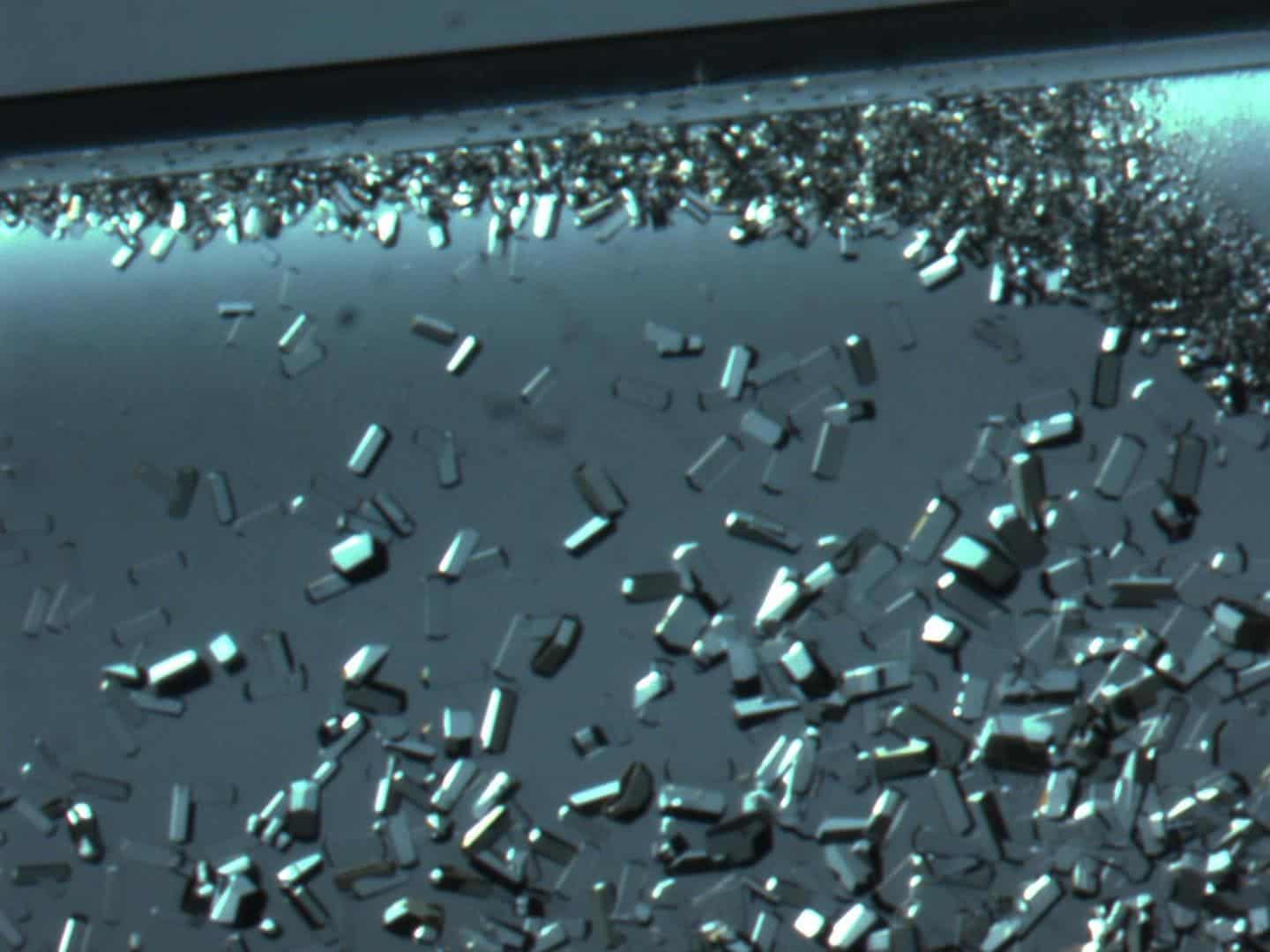Exploring The Use Of Orbital Space Crystals In Drug Creation

Table of Contents
The Unique Properties of Orbital Space Crystals for Drug Synthesis
Crystals grown in the microgravity environment of space exhibit unique physical and chemical properties highly advantageous for drug synthesis. The absence of convection currents and sedimentation in space allows for a more controlled and homogenous crystal growth process. This results in several key improvements:
-
Improved crystal purity and uniformity: Space-grown crystals often exhibit significantly higher purity levels compared to their Earth-grown counterparts. This is due to the reduced influence of gravity-driven sedimentation and convection, which can introduce impurities and imperfections during terrestrial crystal growth. This higher purity translates directly to improved drug efficacy and reduced side effects.
-
Enhanced control over crystal size and shape: Microgravity allows for precise control over crystal size and morphology. This is crucial in pharmaceutical applications, as the size and shape of crystals can significantly impact their bioavailability, dissolution rate, and overall effectiveness. Researchers can fine-tune the growth parameters to achieve the desired crystal characteristics.
-
Potential for novel crystal structures not achievable on Earth: The unique conditions of space may allow for the formation of novel crystal structures and polymorphs that are unattainable using conventional terrestrial methods. These new structures could possess unique pharmacological properties, leading to the development of entirely new drugs with enhanced therapeutic potential.
Examples of crystal types suitable for pharmaceutical applications grown in space include proteins, peptides, and various inorganic materials used as drug carriers or components. The precise control over crystal properties offers opportunities for targeted drug delivery and improved therapeutic outcomes.
Advantages of Utilizing Orbital Space Crystals in Pharmaceutical Research
Utilizing orbital space crystals in pharmaceutical research offers several advantages over traditional terrestrial methods:
-
Increased efficiency in drug synthesis: The highly controlled and uniform crystal growth in microgravity leads to significantly higher yields and reduced processing times compared to Earth-based methods.
-
Reduced production costs (long-term potential): While initial investment and launch costs are high, the increased efficiency and potential for novel drug creation could lead to significant cost reductions in the long term, especially for high-value pharmaceuticals.
-
Creation of novel drugs with improved efficacy and reduced side effects: The unique properties of space-grown crystals could enable the development of drugs with enhanced efficacy, fewer side effects, and improved bioavailability.
-
Potential for faster drug development cycles: The improved efficiency and control offered by space-based crystal growth can shorten the overall drug development timeline, accelerating the availability of new treatments for patients.
For instance, space-grown protein crystals could facilitate the development of more effective protein-based therapeutics, while precisely engineered inorganic crystals could revolutionize drug delivery systems.
Case Studies: Successful Applications of Space-Grown Crystals in Drug Development
While large-scale pharmaceutical production using space-grown crystals is still in its early stages, promising research is underway. Several studies have demonstrated the feasibility of growing high-quality protein crystals in space, with improved diffraction quality leading to more accurate structural determination – a crucial step in drug design. Further research is focusing on the synthesis of novel inorganic nanomaterials for targeted drug delivery and advanced imaging techniques. The potential for successful applications is significant, with ongoing research likely to yield more concrete case studies in the near future.
Challenges and Limitations of Utilizing Orbital Space Crystals
Despite the significant potential, several challenges hinder the widespread adoption of orbital space crystals in pharmaceutical manufacturing:
-
High launch costs: Transporting equipment and materials to space remains extremely expensive, representing a major obstacle.
-
Complex experimental setup in space: Designing and implementing experiments in the microgravity environment requires specialized equipment and expertise, adding complexity and cost.
-
Data transmission and analysis challenges: Efficiently transmitting large datasets from space and analyzing them requires robust communication systems and advanced data processing capabilities.
-
Limited access to space facilities: The availability of suitable space facilities for conducting crystal growth experiments is limited, creating a bottleneck for research.
Addressing these challenges requires advancements in space technology, such as reusable launch vehicles and miniaturized experimental setups. Collaborative research initiatives involving government agencies, private companies, and academic institutions are also crucial to overcome these limitations.
The Future of Orbital Space Crystals in Pharmaceutical Manufacturing
The future of orbital space crystals in pharmaceutical manufacturing is bright, with several promising avenues of development:
-
Advancements in space-based crystal growth techniques: Continuous improvements in space-based crystal growth techniques will increase efficiency and control, leading to higher-quality crystals.
-
Increased accessibility and reduced costs of space-based research: Technological advancements and increased competition could drive down the cost of space access, making space-based research more accessible.
-
Integration of artificial intelligence and automation in space-based drug development: AI and automation can optimize crystal growth processes, enhance data analysis, and accelerate the overall drug development pipeline.
-
Potential for large-scale space-based pharmaceutical production: In the long term, the development of dedicated space-based pharmaceutical manufacturing facilities could become a reality, transforming the landscape of drug production.
The Promise of Orbital Space Crystals in Drug Creation
In summary, orbital space crystals offer significant advantages in drug development, including improved crystal purity, enhanced control over crystal properties, and the potential for creating novel drugs with enhanced efficacy. While logistical and economic challenges remain, advancements in space technology and collaborative research initiatives are paving the way for overcoming these obstacles. The future of drug discovery is bright, and further investment in researching and developing the use of orbital space crystals is essential to unlocking their full therapeutic potential and revolutionizing pharmaceutical innovation.

Featured Posts
-
 Tretiy Final Kubka Billi Dzhin King Dlya Kazakhstana
May 23, 2025
Tretiy Final Kubka Billi Dzhin King Dlya Kazakhstana
May 23, 2025 -
 Creating Clear And Concise Briefs A Practical Guide
May 23, 2025
Creating Clear And Concise Briefs A Practical Guide
May 23, 2025 -
 Rum Culture And Kartel Exploring The Connection In Stabroek News Reports
May 23, 2025
Rum Culture And Kartel Exploring The Connection In Stabroek News Reports
May 23, 2025 -
 Tagliafico Blames Man United Players For Ten Hags Struggles
May 23, 2025
Tagliafico Blames Man United Players For Ten Hags Struggles
May 23, 2025 -
 Honeywell Poised To Acquire Johnson Matthey Unit For 1 8 Billion
May 23, 2025
Honeywell Poised To Acquire Johnson Matthey Unit For 1 8 Billion
May 23, 2025
Latest Posts
-
 Review Jonathan Groffs Just In Time A Captivating Bobby Darin Tribute
May 23, 2025
Review Jonathan Groffs Just In Time A Captivating Bobby Darin Tribute
May 23, 2025 -
 Jonathan Groffs Just In Time A 1965 Style Party On Stage
May 23, 2025
Jonathan Groffs Just In Time A 1965 Style Party On Stage
May 23, 2025 -
 Just In Time Review Jonathan Groff Shines In A Stellar Bobby Darin Musical
May 23, 2025
Just In Time Review Jonathan Groff Shines In A Stellar Bobby Darin Musical
May 23, 2025 -
 Jonathan Groffs Just In Time Performance Exploring The Artistic Process And Raw Talent
May 23, 2025
Jonathan Groffs Just In Time Performance Exploring The Artistic Process And Raw Talent
May 23, 2025 -
 Jonathan Groffs Past An Open Conversation About Asexuality
May 23, 2025
Jonathan Groffs Past An Open Conversation About Asexuality
May 23, 2025
